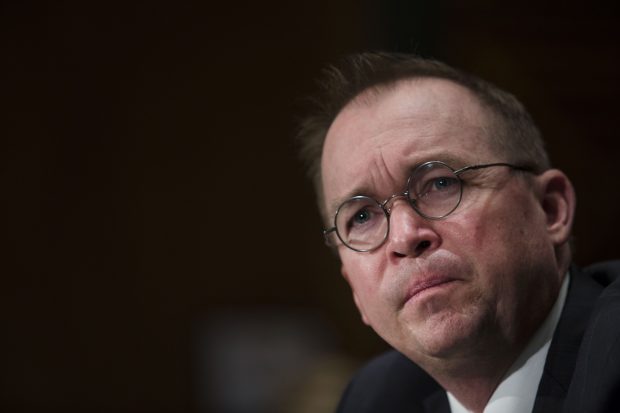
U.S. Senator Elizabeth Warren has accused Mick Mulvaney of waging war on consumers by transforming an aggressive financial regulator into an industry lapdog.
She's not wrong that he's been proactive. Since taking over the Consumer Financial Protection Bureau in November, Mulvaney has dropped investigations into payday lenders, pledged to soften rules and even unveiled a new eagle-emblazoned seal.
But in a surprising twist, it turns out the effort to overhaul the seal was actually initiated by Richard Corday, the Barack Obama-appointed CFPB director who has earned endless praise from Warren and scorn from Republicans. And the seal that Cordray had settled on before he resigned to run for governor of Ohio is very similar to Mulvaney's selection, according to internal CFPB emails obtained by Bloomberg News through a Freedom of Information Act request.
After President Donald Trump named Mulvaney the CFPB's acting director, he started the process over — kind of. The three sample seals Cordray chose from — Seals A, B and C — all used the name Consumer Financial Protection Bureau.
Mulvaney's staff added a Seal D sample to reflect the fact that he is hellbent on getting everyone to refer to the CFPB by the name it was given in its Dodd-Frank designation: the Bureau of Consumer Financial Protection. Mulvaney picked D.
Mulvaney's team had already been trying to shift the name and had taken to calling the place the bureau, rather than CFPB. Brian Johnson — a senior adviser hired from the Republican staff of the House Financial Services Committee — said in an email that it's “important for us to abide by statute” which used the “bureau” version.
But Emma Doyle, the chief of staff of the Office of Management and Budget that Mulvaney runs in his permanent job, pointed out the problem: “The 'CFPB' name is on the website, our stationery, several buildings, previous press releases, pending litigation, etc.”
Doyle advised that the agency would “risk looking like we haven't thought this through” if it executed the name change and new seal without a coordinated strategy. But that strategy wasn't so apparent when the changes started emerging.
The seal was announced in a March blog entry on the agency website. Its eagle-and-shield display “roots the bureau in America's founding documents, combining national symbols with the bureau's values and mission in a traditional presentation,” according to emails.
On April 4, an email from then-Deputy Chief of Staff Kate Fulton explained that the agency “will be gradually using the seal and correct statutory name in more official documents,” and she said that “in order to avoid confusion, the bureau can continue to use the logo and the full name 'Consumer Financial Protection Bureau' in all other matters.”
She added, that “whenever possible” people should use “bureau” instead of “CFPB.”
Then in an April 11 hearing of the House Financial Services Committee, where Mulvaney was once a member, he began publicly undermining the CFPB name.
“I don't know why we call it the CFPB, but that is not the name of the organization,” he said.
After that, the regulator's press releases adopted the statutory name, though the website still uses the longtime CFPB logo.
© Touchpoint Markets, All Rights Reserved. Request academic re-use from www.copyright.com. All other uses, submit a request to [email protected]. For more inforrmation visit Asset & Logo Licensing.






